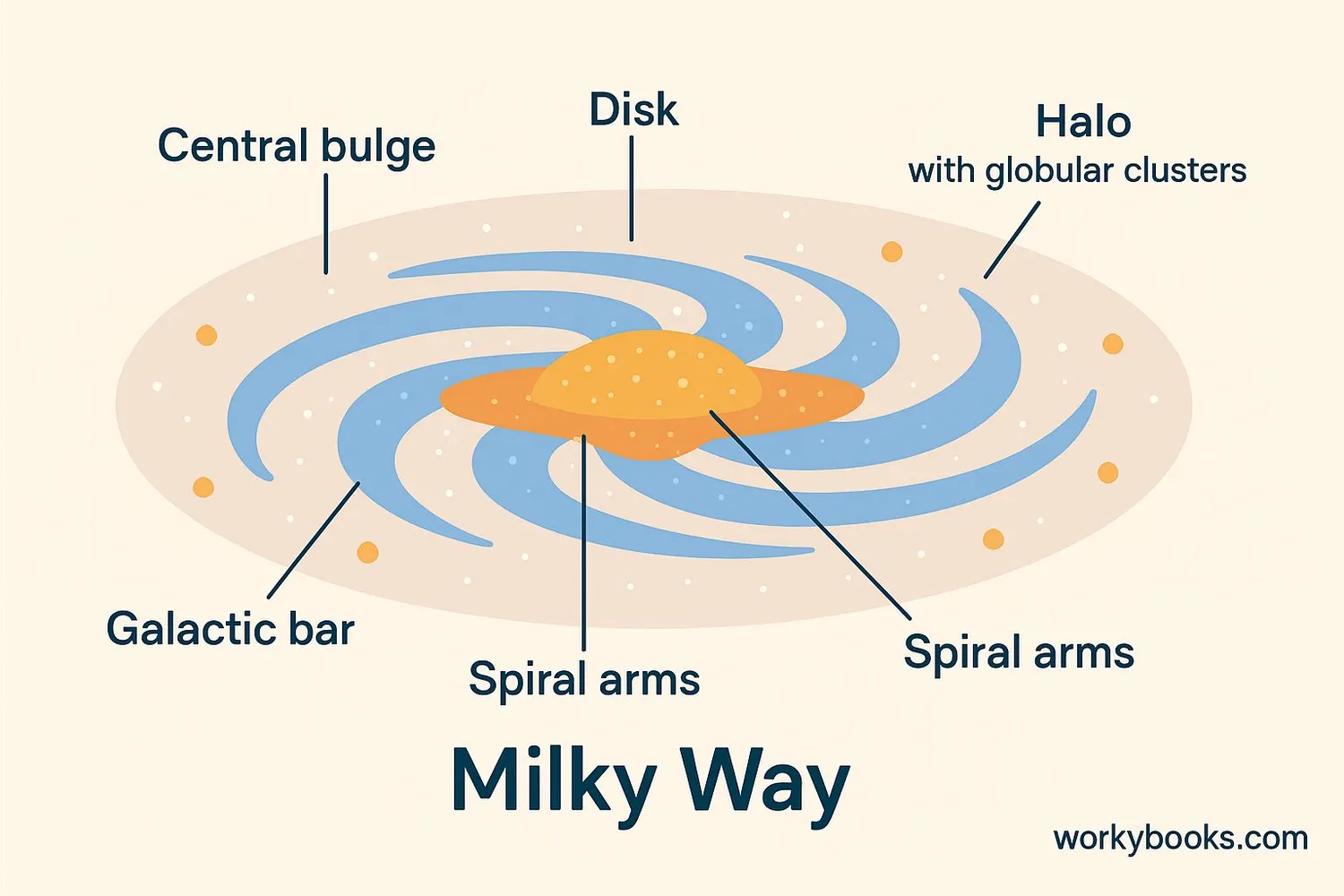Milky Way Galaxy - Definition, Examples, Quiz, FAQ, Trivia
Discover our cosmic home - a vast spiral galaxy filled with stars, planets, and mysteries!
Our Galactic Home

The Milky Way Galaxy is our cosmic neighborhood - a vast collection of stars, planets, gas, and dust held together by gravity. It's called a spiral galaxy because of its beautiful pinwheel shape when seen from above.
Our galaxy contains between 100-400 billion stars, and our Sun is just one of them! The Milky Way is so enormous that light takes about 100,000 years to travel from one end to the other. We live inside this galaxy, which is why we see it as a milky band of light stretching across the night sky.
Galaxy Fact!
The name "Milky Way" comes from ancient Greek mythology, where it was described as spilled milk from the goddess Hera!
Galaxy Structure

Our Milky Way has several important parts that work together to form this magnificent spiral galaxy:
Central Bulge
A dense, spherical region at the galaxy's center filled with older stars
Galactic Bar
A rectangular-shaped structure of stars stretching through the center
Spiral Arms
Curving arms extending from the center where new stars form
Galactic Disk
A flattened region containing most of the galaxy's stars and gas
Galactic Halo
A spherical region surrounding the disk with older stars and globular clusters
At the very center of our galaxy lies a supermassive black hole called Sagittarius A*, which has a mass equivalent to 4 million suns! This black hole doesn't "suck in" everything around it - instead, stars orbit around it just like planets orbit the Sun.
Discovery Highlight
Using the Spitzer Space Telescope, astronomers discovered that our Milky Way has a central bar structure, making it a barred spiral galaxy.
Spiral Arms & Star Formation

The spiral arms are the most active regions in our galaxy, where new stars are constantly being born. Our solar system is located in a smaller arm called the Orion Arm (or Orion Spur). Other major arms include:
Perseus Arm
The major arm outside our position, rich in star clusters
Sagittarius Arm
Closer to the galactic center, with many nebulae
Orion Arm
Our home arm, where the Sun resides
Spiral arms aren't fixed structures but rather patterns of density waves moving through the galaxy. As gas and dust enter these dense regions, they compress and trigger the formation of new stars. This is why spiral arms appear brighter - they contain many massive, young, hot stars that shine with blue-white light.
Our solar system orbits the galactic center at about 515,000 mph (828,000 km/h)! Even at this incredible speed, it takes about 225-250 million years to complete one orbit around the galaxy - a period called a "galactic year."
Galaxy Quiz
Test your Milky Way knowledge with this space quiz! Answer all 5 questions to see how much you've learned.
Frequently Asked Questions
Here are answers to some common questions about our galaxy:
Galactic Trivia
Discover some amazing facts about our Milky Way Galaxy!
Immense Size
The Milky Way is about 100,000 light-years across. If you could drive across it at highway speed (60 mph), it would take you more than 2 trillion years!
Speeding Through Space
Our entire galaxy is moving through space at approximately 1.3 million miles per hour (2.1 million km/h) toward the constellation Leo.
Invisible Matter
About 85% of the Milky Way's mass is dark matter - material that doesn't emit light and can only be detected by its gravitational effects.
Ancient Galaxy
The Milky Way is about 13.6 billion years old - almost as old as the universe itself! The oldest stars in our galaxy formed just a few hundred million years after the Big Bang.


